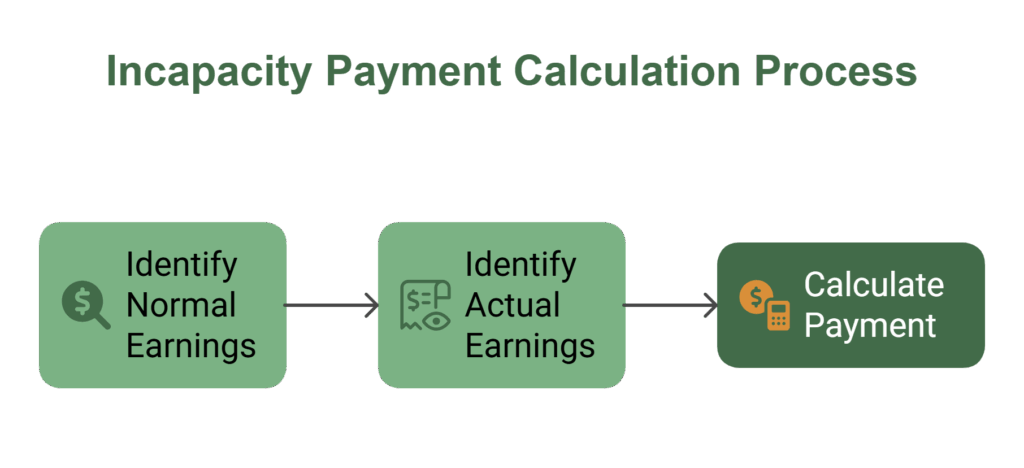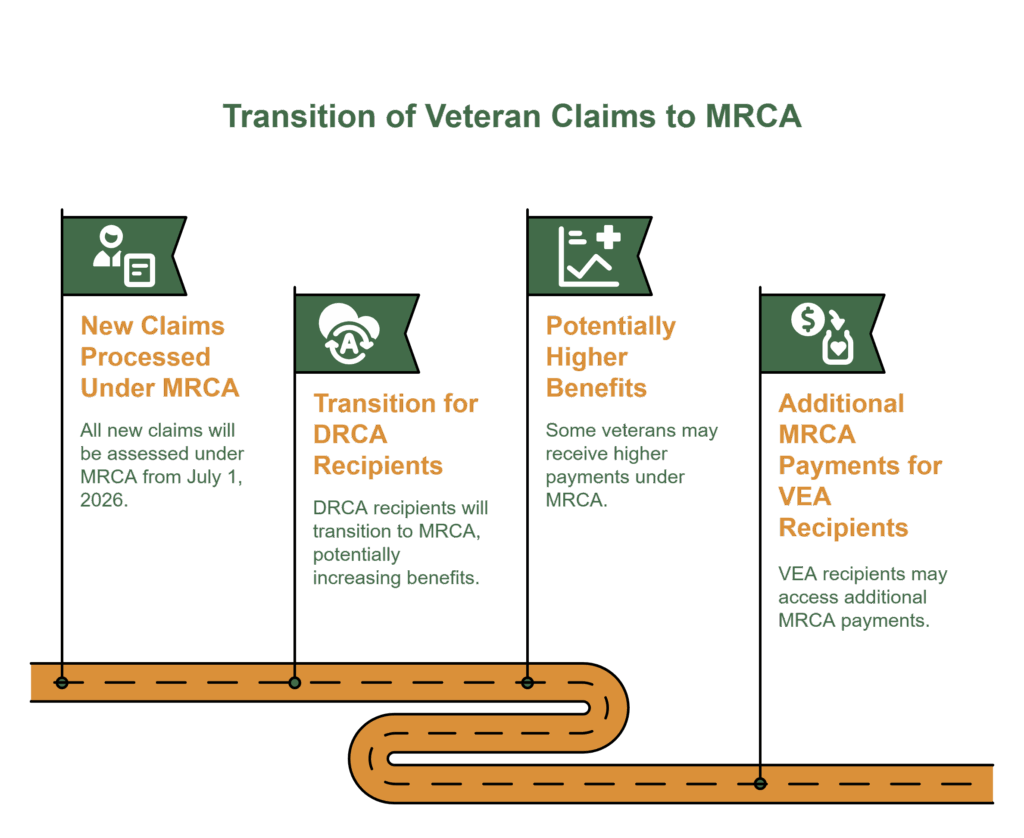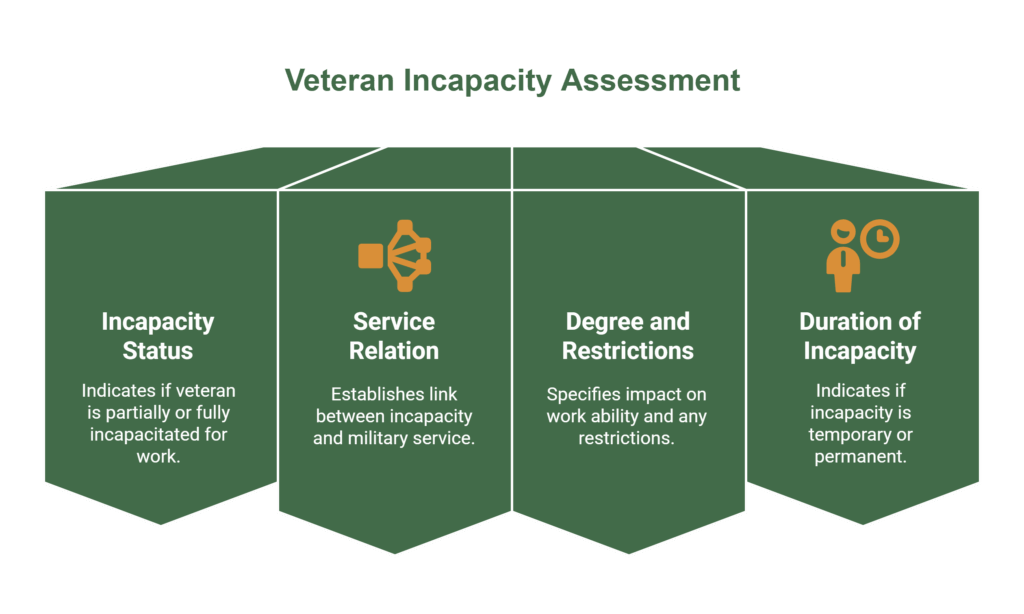For many veterans, the move from active service to civilian life comes with challenges. This can be especially true when injuries or health conditions from service make it harder to work. Incapacity payments can provide much-needed financial support, helping to bridge the gap when earning capacity has been affected by military service.
If you’re a veteran trying to understand your options, or you’re supporting someone who has served, knowing how these payments work can make a big difference. It can help you feel more in control and confident about what comes next.
Key takeaways
- Veterans must meet eligibility requirements as outlined under MRCA or DRCA.
- Payments are calculated based on income loss, with initial full support for 45 weeks before adjusting based on work capacity.
- Major reforms in July 2026 will transition DRCA recipients to MRCA and potentially increase benefits for some veterans.
- Medical certification is mandatory to receive and continue incapacity payments.
- Veterans can access official resources to better understand their entitlements and receive assistance.
What Are Incapacity Payments?
Incapacity payments are designed for veterans who can’t work, or can’t work as much as they used to, because of injuries or illnesses linked to their service. They’re designed to compensate for lost income and support veterans as they transition to life after the military.
Unlike disability pensions, which are based on the level of impairment, incapacity payments focus on the difference between what a veteran used to earn and what they can earn now.
These payments are covered under two main laws:
- The Military Rehabilitation and Compensation Act 2004 (MRCA)
- The Safety, Rehabilitation and Compensation (Defence-related Claims) Act 1988 (DRCA)
Which one applies depends on when your condition was accepted and the type of service you had. While the details vary, both are designed to help make the financial side of post-service life more manageable, especially when health issues make working difficult.
Eligibility Criteria for Incapacity Payments
To be eligible for incapacity payments, a veteran must satisfy the following conditions:
Service Eligibility
The individual must be a current or former member of the Australian Defence Force (ADF).
This includes:
- Permanent Force members
- Reserve Force members
- Cadets
- Declared members under the relevant legislation
Medical Certification of Incapacity
Veterans must provide medical evidence confirming their incapacity to work due to a service-related condition.
A medical certificate should detail:
- The extent of incapacity (partial or total).
- Whether the condition is directly linked to military service.
- Any restrictions on work capacity.
Veterans who meet these criteria can apply for incapacity payments, which aim to bridge the financial gap between their pre- and post-injury earnings. If you need assistance getting connected to a veteran-friendly GP, our dedicated support team can help.
How Incapacity Payments Are Calculated
The amount a veteran receives in incapacity payments depends on their normal earnings before incapacity and their actual earnings during incapacity. The goal is to compensate for lost income while encouraging veterans to engage in work as much as their condition allows.
Calculation Formula
The payment is based on the difference between:
- Normal Earnings (pre-injury income)
- Actual Earnings (current income, if any)

Payment Structure
First 45 Weeks
- Veterans receive 100% of their normal earnings, minus any actual earnings and Commonwealth superannuation payments.
- This ensures veterans have financial stability while recovering or transitioning to new work arrangements.
After 45 Weeks
The payment rate reduces and varies based on the veteran’s capacity to work:
- 75% to 100% of normal earnings.
- The exact percentage depends on the number of hours the veteran is medically able to work.
Example Scenario
For example, let’s say a veteran was earning $1,500 a week before their injury and can now only manage $500 a week:
First 45 weeks: They receive the full $1,500 minus the $500 they now earn, resulting in a $1,000 incapacity payment per week.
After 45 weeks: The payment may drop to between $750 and $1,000 per week, depending on their assessed work capacity.
Knowing how these payments are calculated can help veterans feel more in control of their finances. If it feels confusing, our team is here to walk you through it and help you understand what you may be entitled to.
Major Changes Coming in July 2026
From 1 July 2026, the incapacity payment system will be updated to simplify and standardise the process for veterans. The reforms aim to reduce confusion, bring payments under one framework, and may result in higher support for some veterans.
All New Claims Will Be Processed Under MRCA
From 1 July 2026, all new incapacity payment claims will be handled under one law – the Military Rehabilitation and Compensation Act 2004 (MRCA). Even if your condition was originally accepted under the older DRCA system, any new claims will now follow MRCA rules.
MRCA offers a more modern approach, with a stronger focus on rehabilitation and support. For many veterans, this could mean clearer processes and potentially higher payments.
You won’t lose any existing entitlements, but the way your payments are structured might change. If you’re not sure how this affects you, the team at VetComp can talk you through it and help you understand what you may be eligible for.

How Incapacity Payments Affect Other Veteran Benefits
Incapacity payments can make a big difference for veterans managing reduced work capacity, but they may also affect other benefits like service pensions. Knowing how these payments work together helps you make better decisions and avoid unexpected changes to your income.
Impact on Service Pensions
Before Age Service Pension Age
- Incapacity payments reduce VEA service pension payments dollar-for-dollar.
- This means that for every dollar received in incapacity payments, the veteran’s service pension is reduced by the same amount.
- Why this matters: Veterans receiving both payments may not see an overall financial gain, as incapacity payments will directly offset their pension.
After Reaching the Age Service Pension Age
Once a veteran reaches Age Service Pension age, incapacity payments are counted as income when determining pension rates.
This means:
- The amount of incapacity payments received could impact eligibility and rates for other government pensions.
- Veterans under financial hardship may face reassessments based on income thresholds.
- Key Consideration: Veterans approaching the Age Service Pension age should seek guidance on how their incapacity payments may affect long-term pension entitlements.
The Role of Medical Certification in Incapacity Payments
Medical certification is a key part of getting incapacity payments. It confirms that your condition affects your ability to work and helps determine how much support you should receive.
Veterans Must Provide Updated Medical Certification Confirming:
- Current Incapacity Status: The certificate must indicate whether the veteran is partially or fully incapacitated for work.
- Whether Incapacity is Directly Related to Service: The medical report must establish a clear link between the incapacity and military service.
Degree of Incapacity and Work Restrictions
- Specifies how much the veteran’s ability to work is impacted.
- Details any work restrictions (e.g., limited hours, physical activity restrictions, modified duties).
Duration of Incapacity for Work
- Indicates whether the incapacity is temporary or permanent.
- If temporary, the veteran may need to submit updated medical reports periodically to continue receiving payments.

Why Medical Certification Matters
Without an up-to-date medical certificate, your incapacity payments could be delayed or even stopped. This certificate confirms how your condition affects your ability to work and helps DVA calculate your support correctly. It needs to show not just your current capacity but also how your condition links back to your service.
Staying on top of this paperwork can be frustrating, especially if you’re already dealing with health issues. That’s where we come in. We can help connect you with GPs who are familiar with DVA processes and ensure that your documentation accurately reflects your situation. Reach out to our team, we’re here to make things easier.
Resources for Further Information
Veterans navigating incapacity payments can access official guidance and support from multiple resources. These sources provide up-to-date information on eligibility, payment calculations, and legislative changes.
Department of Veterans’ Affairs (DVA) Website – www.dva.gov.au
- The official government source for all veteran-related benefits, including incapacity payments.
- Provides detailed information on claims, eligibility, and legislative updates.
Relevant Legislation
- Military Rehabilitation and Compensation Act 2004 (MRCA) – Covers incapacity payments for veterans with service after July 1, 2004.
- Safety, Rehabilitation and Compensation (Defence-related Claims) Act 1988 (DRCA) – Covers incapacity claims prior to July 1, 2004.
- Veterans' Entitlements Act 1986 (VEA) – Governs Disability Compensation Payments (DCP) and other veteran benefits.
Parliamentary Reports on Veteran Support
- Reports from the Australian Parliament provide in-depth insights into veteran financial support systems.
- These documents offer a broader policy perspective on incapacity payments.
Social Security Guide from the Department of Social Services
- Details how incapacity payments interact with other government benefits.
- Crucial for veterans concerned about pension eligibility and income assessments.
Veterans and their families are encouraged to stay informed and check their eligibility for incapacity payments. Visit the Department of Veterans’ Affairs website or reach out to our team at VetComp to ensure you’re receiving the benefits you deserve.
FAQs
We’ve gathered our most commonly asked questions here, so you can feel informed, at ease, and ready to take the next step toward the support and benefits you deserve.
Who can apply for incapacity payments?
Any current or former member of the Australian Defence Force, including Permanent and Reserve Force members, cadets, and declared members, can apply if they have a service-related injury or illness that affects their ability to work.
Do I need medical evidence to receive incapacity payments?
Yes. You’ll need a medical certificate from a doctor confirming how your service-related condition impacts your capacity to work. This must be kept up to date to continue receiving payments.
How are incapacity payments different from disability pensions?
Incapacity payments focus on income loss. They bridge the gap between what you used to earn before your condition and what you can earn now. Disability pensions, on the other hand, are based on the level of permanent impairment.
How much will I receive in incapacity payments?
The amount is based on your normal pre-injury earnings compared to what you can earn now. For the first 45 weeks, you’ll usually receive 100% of your pre-injury earnings (minus any income and Commonwealth super).
After that, the rate adjusts depending on your assessed work capacity.
What changes are being made in July 2026?
From 1 July 2026, all new incapacity payment claims will be handled under the MRCA system. This reform aims to simplify the process and may provide higher benefits for some veterans.
If you’re already on DRCA, your current entitlements remain, but any new claims will be processed under MRCA.
Can I still work while receiving incapacity payments?
Yes. You can work to the extent that your condition allows. Payments are designed to make up the difference between your pre-injury and current earnings, so even part-time or limited work is supported.
What if my incapacity is only temporary?
You can still receive incapacity payments, but you’ll need updated medical certificates until your condition stabilises. If your capacity changes, your payments may be reassessed.



